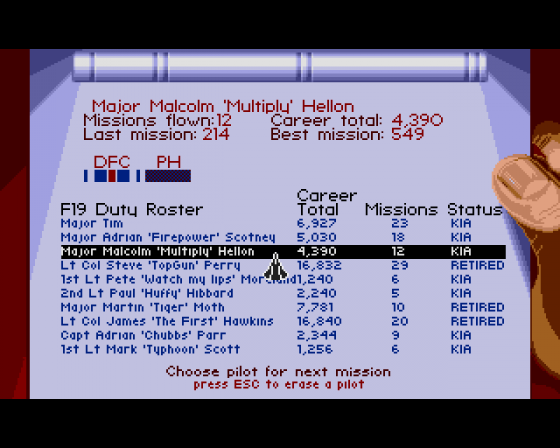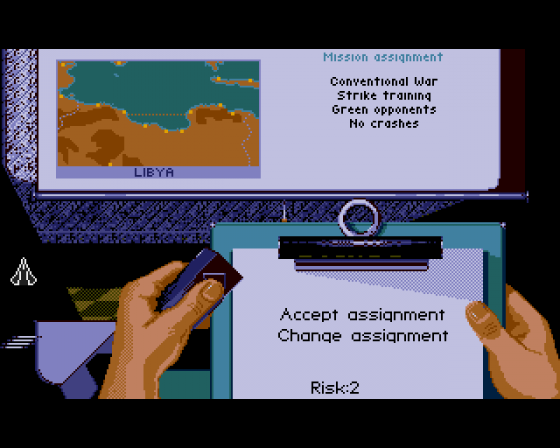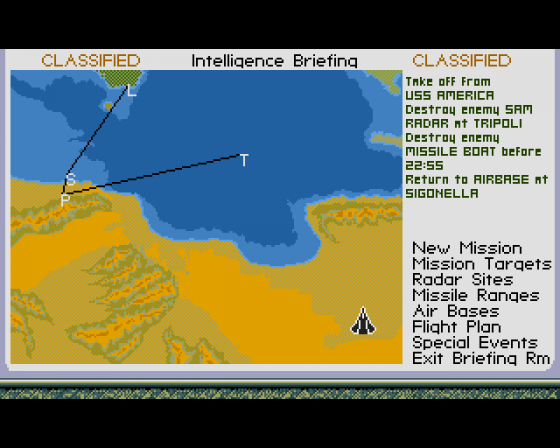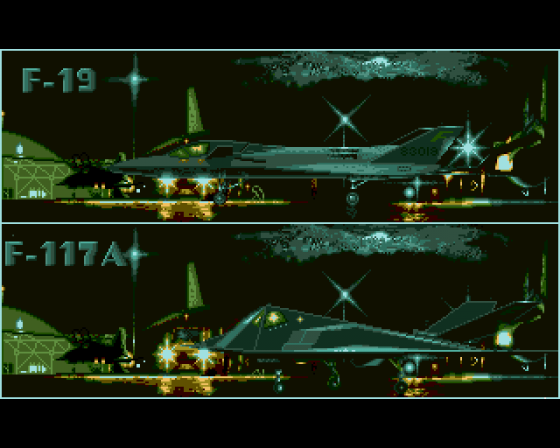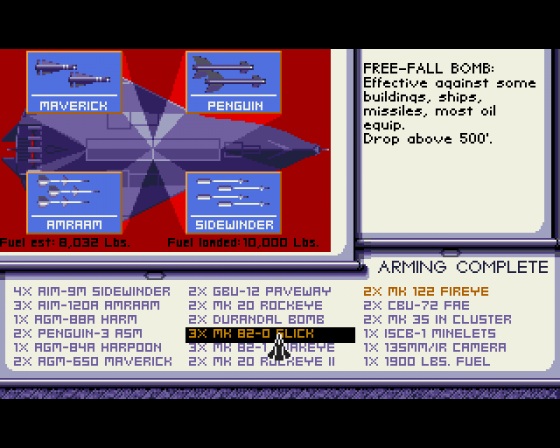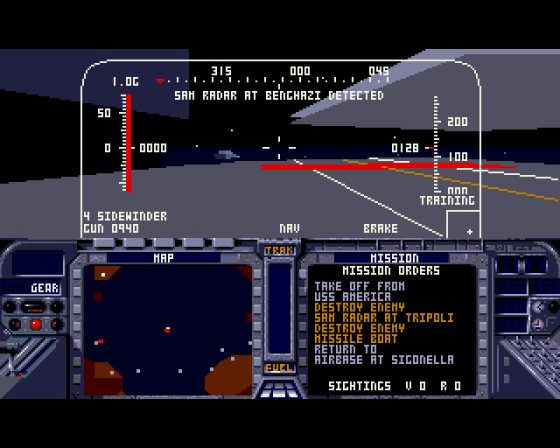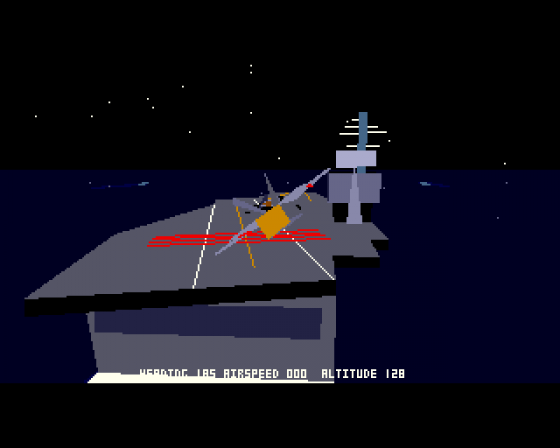
The One
 1st March 1989
1st March 1989
Categories: Review: Software
Author: Declan McGolgan
Publisher: Microprose
Machine: Amiga 500
Published in The One #6
Always quick off the mark, Microprose's latest flight program simulates an aircraft which has only just come out from under wraps. PC User's Declan McColgan takes to the air for an early test flight.
F-19 Stealth Fighter
As far as flight 'n fight simulation goes, F-19 Stealth Fighter from Microprose is hard to beat. It comes from the same stable that gave an ungrateful world Gunship and F-15 Strike Eagle, and very little can live in the same RAM chips with it.
The reasons for this enthusiasm are twofold: firstly, there's incredible depth - I fully expect to be playing this for years before having flown all the missions - and secondly the graphics show off the capabilities of the PC's VGA in its best light. In this latter respect, it's particularly strong, leaving 'realistic' packages such as Microsoft's Flight Simulator III a long way behind.
In real-life, the F-19 is a high-tech warplane almost impossible to pick up on radar thanks to a combination of its shape, the materials from which it is constructed, an array of radar-jamming devices, and its low-flying capabilities. It was designed at Lockheed's famous 'Skunk Works' in Burbank, California, and is used primarily for ground strikes behind enemy lines.
The program offers a choice of operations in any of four theatres of war: Libya, the Persian Gulf, the Northern Cape and Central Europe. Missions are flown either during the Cold War, when clandestine missions are carried out, Limited War or all-out Conventional War, and you can be flying against green, regular, veteran or elite opponents.These factors determine the difficulty level, with even the simpler levels posing a real problem. Thankfully, there's a training mode where you don't pay for mistakes with your life (although your reputation is likely to suffer).
The documentation provided is indispensable. There's a complete keyboard overlay, so you don't have to remember which key, or combination of keys does what, and the manual is little short of breathtaking. It includes a complete training programme, operating instructions, techniques and tactics (including radar and stealth tactics), comprehensive military information about the four theatres of war, and exhaustive information about weapons and warplanes - both ours and theirs.
Microprose claims that F-19 is simple to learn but difficult to master - and that's a fair summation. As your flying improves, you get promoted within the Air Force. Unfortunately, this also means that you're allocated tougher missions.Before you go anywhere you have to know your airplanes. Make a correct identification and you get to pick your own mission; fail and one is picked for you. Fortunately the manual carries a guide to all the aircraft found throughout the program.
Right. We're off to Libya, and, as you can see, I've selected strike training in a conventional war situation with regular opponents and no crashes (as opposed to easy or realistic landings). One of the nice things about F-19 is that it can be quite forgiving. In training, for instance, if you get clobbered by a missile, you don't have to go back and start all over again, but can carry on and hopefully manage to avoid the next one.
During the intelligence briefing, you'll learn about the enemy's defensive capabilities. The radar data at top right refers to the radar station encircled in white, and similar information is available about all radar stations, missile sites, air bases, etc.At this point you can review the intelligence briefing, re-arm your jalopy or ask to be sent on a different mission, but this is regarded as a singularly cowardly act.
We'll just let that chappie take off ahead of us while we check out our waypoints, which are pre-selected points mapping our way to the targets and back. If you get diverted from the planned course, the waypoints can be changed and reset during the flight. The onboard computer has already sniffed out a surface-air missile station.
Now it's getting interesting. With the left-hand CRT switched from the satellite map to tactical mode. I can see my position relative to other targets. With the HUD now in air-air mode, missile tracking cameras have picked up an F-18 to the rear, but he's too far away to be concerned with. The red bar in the centre tells me I'm showing far too much to ground radar stations.This is a more interesting customer, a MiG-29 to the left. The onboard computer carries information about his armaments, speed, range, etc, shown on the right-hand CRT. To shoot anything down, incidentally, you've got to get it in front of you.
Er, moving swiftly on to another mission, this time by day, here we are from behind at full tilt over the Sahara. Gadafy, no doubt, is quaking in his boots.
Despite the disturbingly large number of bandits in the area, I nonetheless venture off to do battle over darkest Finland (or brightest, depending on the time of year!), this time looking on from outside the aircraft as I take off, afterburners blazing.With a little shimmy called "the Scissors Turn", learned from the God-send manual, I soon get on his tail, but just as I loose a Sidewinder, one of the ground stations shoots at me. I told you this was a hairy place - and this is only a training mission against regular class opponents, for Pete's sake!
Another missile is dispatched, this time to take care of a pesky MiG-23. His position relative to mine is shown on the Tactical display. I've been in the wars a bit myself, however, and a red indicator on the right warns me that I've exhausted my store of decoys, so perhaps it's time I was 'opping it.
Sure enough, a quick peek out the back window reveals a MiG-31 Foxhound interceptor on my tail. And, as they say, he ain't come to borrow some sugar (or a Diet Pepsi for that matter).So I say, in time-honoured tradition, "Let's get the Hell out of here," and point her nose for home. There's an airstrip in them thar hill... somewhere.
PC
Compulsive, addictive and ruinous to your social life. Only a couple of packages can compare with this. The graphics are quite superb, and the manual makes enthralling reading, even if you never go near the game. The only flaw I can see is that a lot of the effect is lost by slower machines using a GCA card. However, faster EGA and VGA owners are in for an airborne treat.
ST
Although Commodore owners won't see a finished product until late Summer, the development team is already claiming that it's moving faster and looking even better than the IBM-compatible model.
Amiga
This version is due for simultaneous release with the Amiga product, however no details of price or availability have been released as yet.
Other Reviews Of F-19 Stealth Fighter For The Amiga 500
F-19 Stealth Fighter (Microprose)
A review
F19 Stealth Fighter (Microprose)
A review
Scores
Atari ST Version| Graphics | 87% |
| Sound | 68% |
| Playability | 83% |
| Value For Money | 90% |
| Overall | 91% |
Scores
Amiga 500 Version| Graphics | 87% |
| Sound | 68% |
| Playability | 83% |
| Value For Money | 90% |
| Overall | 91% |



